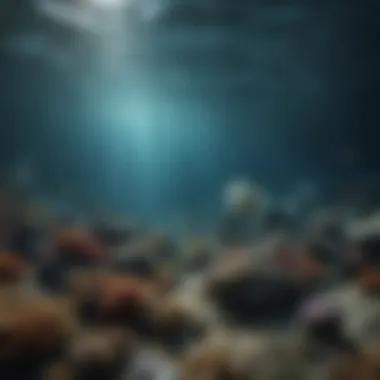Understanding Ocean Noise Pollution and Its Effects


Intro
The deep blue ocean, a vast expanse that covers over 70% of our planet, is not just a lifeless body of water. It's a bustling metropolis, filled with life forms communicating, hunting, and surviving in intricate ecosystems. Yet, this serene environment is increasingly disturbed by an issue that flies under the radar for many: noise pollution. So many of us have little idea about how much sound impacts marine life, and that’s what we need to shed light on.
Noise in the ocean comes from various sources, including shipping traffic, industrial activities, underwater construction, and even natural phenomena like earthquakes. The sounds produced by these activities intertwine with natural sounds that marine creatures depend upon for communication, mating, and navigation.
Research Highlights
Key Findings
The consequences of excessive noise pollution are affecting biodiversity. Research has shown that certain species, such as whales and dolphins, use echolocation to navigate and find food. When anthropogenic noise disrupts their communication, it can lead to disorientation and potential threats to their survival. A key finding from recent studies suggests a direct correlation between chronic noise exposure and increased stress levels in marine animals. This chronic stress impacts their reproductive success and can lead to population declines.
Additionally, a report revealed that younger fish, which rely heavily on sound to locate safe habitats, are becoming less able to hear the sounds of predators due to the increasing background noise levels.
Implications and Applications
Understanding the effects of noise pollution is crucial for developing effective conservation strategies. The kinds of insights gained from current research can inform frameworks for managing human activities to protect vulnerable marine species. Policies need to account for soundscapes in marine environments—ensuring that laws surrounding shipping, construction, and other industries consider their impact on underwater life.
-> "To genuinely protect marine ecosystems, we must listen to what the ocean is trying to tell us."
Methodology Overview
Research Design
To delve into the impacts of noise pollution, various research methodologies have been employed. For instance, acoustic monitoring has become a crucial tool. By deploying underwater microphones, researchers can record and analyze the sounds in different marine environments over time. This method allows for a comprehensive understanding of how noise levels change with human activity.
Experimental Procedures
Field studies often involve two key components: data collection and species observation. In some experiments, researchers measure noise levels during specific activities, say, during high shipping traffic vs. calm periods. These collected data sets are then correlated with behavioral analyses of marine species, such as changes in vocalizations or altered migration patterns.
In essence, these methods not only offer a clearer picture of the varying noise levels but also provide insight into the direct effects this pollution has on marine life. This comprehensive approach ensures that researchers can pinpoint specific causes of disruption that need to be addressed.
As we further explore the disruptions to our oceans, we must keep in mind not only the immediate effects but also the long-term consequences that noise pollution may usher in for marine ecosystems.
Preamble to Ocean Noise Pollution
As we navigate the complex relationships within our marine ecosystems, the significance of ocean noise pollution rises to the forefront. In this age of rapid industrialization and technological advancement, the cacophony of human activities casts a long shadow over the underwater environments that are home to countless species. Understanding the intricacies of this issue is paramount not only for marine life but also for the overall health of our planet.
A deep dive into this topic reveals a wealth of considerations that merit attention. First, defining the very nature of noise pollution in marine contexts is essential. This articulation serves as a launchpad for exploring its varied origins and assessing its impacts. Notably, different sources of noise can have diverse effects on marine species, altering their behavior and, ultimately, ecosystem health.
Moreover, a historical overview of oceanic soundscapes provides valuable insights into how noise levels have evolved over time, reflecting the industrial and societal changes that have transpired. The shifts in sound, from the natural rhythms of the ocean to the disruptive sounds of shipping and military sonar, underscore the metamorphosis of marine environments.
In this section, we will delve into:
- What characterizes noise pollution within the oceanic spheres?
- How have ocean soundscapes changed historically, and what does it mean for marine biodiversity today?
By examining these facets, we can appreciate the pressing need to address noise pollution, and its implications stretch beyond just marine life, reaching into the well-being of coastal communities and the ecological frameworks that support life as we know it.
Sources of Underwater Noise
Understanding the sources of underwater noise is crucial in exploring its impact on marine ecosystems. Noise pollution arises not only from human activities but also from natural phenomena. As we dissect these sources, we can highlight how they contribute to the overall soundscape of our oceans.
Commercial Shipping Activities
Commercial shipping stands as one of the leading contributors to ocean noise. A large cargo ship can create noise levels that reach up to 180 decibels, which is akin to standing next to a jet engine. This cacophony is primarily due to propellers, engines, and the hull interacting with water.


The sheer volume of maritime traffic plays a pivotal role here. It’s not just the noise that’s problematic, but also its persistence. These vessels operate year-round, making the ocean a less hospitable environment for many marine species reliant on sound for communication and navigation.
"The ocean is a noisy place, and for marine mammals that use sound as their language, it can be as disruptive as urban traffic is to city dwellers."
Marine Construction and Dredging Operations
Construction activities in or near coastal waters, such as bridge-building or dredging, produce significant underwater noise. These operations employ heavy machinery that can reverberate through water, impacting local marine life. For instance, pile-driving, a common practice, is notorious for generating intense noise pulses that can travel long distances underwater.
Such noise can interfere with perception for species like dolphins and whales, who depend on echolocation to hunt and socialize. Moreover, continual construction can lead to habitat degradation, ultimately causing fish populations to dwindle. Understanding these nuisances could inspire better practices for minimizing noise during construction projects.
Sonar Use in Military and Scientific Applications
The utilization of sonar is a mixed bag when examining ocean noise sources. Sonar is essential for both military purposes and scientific research, enabling explorations of the ocean floor or detecting submarines. However, the sound waves emitted can be incredibly disruptive.
High-frequency sonar systems can travel vast distances, impacting marine life that relies on low-frequency calls. Reports indicate that whale strandings may correlate with sonar use, highlighting a critical intersection of technology and ecology. As military and scientific objectives often take precedence, finding a balance between these needs and marine health is increasingly significant.
Natural Sources of Ocean Noise
Interestingly, not all underwater noise comes from human activity. Natural elements contribute a considerable share to ocean soundscapes as well. Underwater volcanoes, earthquakes, and even marine fauna create sound.
For example, snapping shrimp can produce sounds that can reach up to 200 decibels. Then there are the rhythmic calls of humpback whales that resonate across ocean basins. This natural noise serves various ecological purposes, such as attracting mates or signaling alarm, showcasing that not all noise is inherently negative.
In short, grasping the origins of underwater noise helps in assessing its implications for marine life. By understanding these diverse sources, we uncover pathways for developing effective strategies to mitigate noise pollution and enhance health of our oceans.
Ecological Impacts of Ocean Noise
The escalating levels of underwater sound present a profound dilemma for marine ecosystems. Noise pollution in the ocean does not merely impair human activity; it reverberates through the intricate web of marine life, disrupting everything from communication to migration patterns. Understanding the ecological impacts of this pollution is indispensable for both conservationists and policymakers, as it sheds light on the balance between industrial advancements and marine health.
Effects on Marine Mammals
Marine mammals are particularly vulnerable to noise pollution due to their reliance on sound for various life processes.
Altered Communication Patterns
Marine mammals, like whales and dolphins, primarily employ echolocation and vocalizations to communicate, navigate, and hunt. Altered communication can lead to significant challenges in social interactions and even in finding food. The intrusion of background noise can mask important sounds, resulting in misunderstandings. Notably, the complexity of these altered communication patterns leads to a ripple effect; if these animals can’t converse and coordinate, their social structures may weaken, impacting their overall population dynamics. A key characteristic here is the inability to detect predators or prey effectively, making "Altered Communication Patterns" essential in our discussions about marine noise.
Disruption of Migration Routes
Many marine species follow intricate migratory paths to reach breeding grounds or feeding zones. Noise pollution can alter these routes, pushing creatures into unfamiliar territories. For instance, the cries of a passing cargo ship can reroute a baleen whale, compelling it to take a longer, more perilous route. Such disruptions not only threaten individual species but can also lead to population declines as they struggle to locate mates or suitable habitats. This topic emphasizes the interdependence of marine life and their environments, making "Disruption of Migration Routes" a critical focal point for understanding the full scope of noise's impact.
Impacts on Reproduction and Health
The well-being of marine mammals hinges on their ability to reproduce and care for their young. Excessive noise may result in stress responses that affect reproduction rates. For example, overly loud environments may cause female seals to abandon their pups, or distortively impact the gestational health of aquatic mammals. A notable consequence is the difficulty in raising offspring in a world filled with distracting sounds. Thus, addressing "Impacts on Reproduction and Health" is paramount for assessing the broader ecological implications of noise pollution.
Impact on Fish Populations
Fish, the backbone of marine ecosystems, also feel the strain from underwater noise. Their behaviors are intricately linked to sound, which they use to communicate, find food, and avoid predators.
Disruption of Feeding Behaviors
Loud marine environments can mask the sounds of prey, making it harder for fish to hunt effectively. A fish might miss the cues of an impending meal due to the overwhelming hum of a nearby vessel. This disruption not only leads to individual starvation but can also affect the overall health of fish populations, compromising their ability to reproduce. Therefore, the category "Disruption of Feeding Behaviors" resonates significantly throughout this article, emphasizing its role in connecting levels from individual fish to the entire ecosystem.
Changes in Habitat Use
Fish often modify their habitat based on sound. Noise pollution can lead to avoidance of important areas, like breeding grounds or nursery sites. When fish shift habitats due to noise, they may end up in less favorable conditions, pushing them further into environmental stress. The discussion on "Changes in Habitat Use" elucidates the connections between soundscapes and fish behavior, highlighting how essential these habitats are for lifecycle continuity.


Consequences for Coral Reefs
Coral reefs are vulnerable ecosystems that greatly influence marine biodiversity. They are affected both directly and indirectly by noise pollution.
The interplay between noise and the health of coral reefs often manifests itself through the behaviors of species that inhabit these areas. Increased noise can lead to enhanced stress levels in both the predatory and prey species. This imbalance may exacerbate conditions for algae overgrowth which competes with coral for resources. Understanding the nexus of noise and coral health further emphasizes the need to monitor underwater soundscapes to protect these vital ecosystems.
In summary, the ecological impacts of ocean noise stretch far and wide, influencing communication, migration, reproduction, feeding, and the very structure of marine ecosystems. It brings to light the crucial need for coherent conservation strategies that take into account the often-overlooked elements of sound in marine environments.
Human Health Implications
In recent years, researchers have begun to shed light on how ocean noise pollution doesn’t just disrupt marine life — it also has a ripple effect impacting coastal communities and human health. As noise levels in the ocean continue to rise, various health concerns appear on the horizon, demanding attention and understanding. The interplay between a noisy ocean and human well-being poses questions about the long-term consequences that may arise from ignoring this issue.
Connection Between Ocean Noise and Coastal Communities
Coastal communities often thrive on the bounties the ocean provides, from fishing to tourism. However, the increasing drone of marine noise pollution threatens this delicate harmony. Loud marine environments can make it difficult for fishermen to locate their target species, as many fish rely on sound for communication and navigation. Disruption to their natural activities may lead to decreased fish populations, further affecting livelihoods and local economies.
Moreover, coastal residents can find themselves continually exposed to the sounds emanating from maritime traffic and construction activities, potentially leading to a range of health problems.
- Effects on Local Economies: As fish populations dwindle and tourist experiences diminish due to noise interference, local businesses that depend on these activities suffer substantially. If the whales stop singing, tour operators might face a downturn in business, or if fishermen struggle to find catch, the local markets might feel the pressure.
- Community Well-Being: The unremitting din of ocean noise pollution can also intrude on the quality of life for those living near the coast. People may experience increased stress levels, sleep disturbances, and even heightened anxiety due to the constant barrage of sounds. This not only affects mental health but can have tangible implications on physical health in the long run.
Psychological Effects of Marine Noise Pollution
The connection between marine noise and psychological health is an emergent field, yet the early findings raise some eyebrows. As coastal areas become louder, studies suggest that there's a correlation between increased marine noise pollution and various mental health issues among residents.
- Stress and Anxiety: Continuous exposure to disruptive environmental noise can lead to heightened stress levels. This stress could amplify feelings of anxiety, which may lead to serious mental health concerns over time.
- Loss of Connection with Nature: Life near the shores is often cherished for its tranquility and connection to nature. However, when the sounds of nature are overwhelmed by industrial or shipping noise, people's sense of peace can vanish. Some might feel disconnected from their environment, leading to what is termed "nature-deficit disorder" — a concept suggesting that many of us experience a detriment when deprived of natural sounds.
- Impact on Community Cohesion: Noise pollution may even dampen social interactions. If people avoid the beach due to noise, community bonding activities diminish. This can weaken social ties within coastal communities, creating a cycle of isolation and distress.
"The ocean’s song has been drowned out by human sounds, leaving communities to grapple with both the ecological and existential consequences."
In summary, the implications of noise pollution are not confined to the marine ecosystem alone. As such, addressing these human health implications must be a crucial part of discussions surrounding marine noise pollution. It’s not just the whales that need a voice — the well-being of coastal communities deserves attention too.
Mitigation Strategies
Noise pollution in the oceans poses a serious threat to marine life and ecosystems. Consequently, establishing effective mitigation strategies is paramount in addressing this pressing concern. Such strategies not only aim to protect biodiversity but also help in maintaining the balance between human activities and environmental health. The importance of mitigation lies in its multifaceted approach that includes regulatory measures, technological advancements, and community engagement.
Regulatory Frameworks and Guidelines
Regulating ocean noise pollution involves the creation of comprehensive frameworks that set boundaries on sound emissions. Different nations have initiated various guidelines aimed at managing noise from maritime activities. For instance, the International Maritime Organization (IMO) has put forth recommendations for quieter ship designs. These frameworks help establish standards that can be universally adopted, promoting a collective effort worldwide.
Among the crucial elements of these regulations are:
- Noise limits for different types of vessels.
- Permits required for construction or any activities likely to emit significant underwater sound.
- Reporting frameworks that allow monitoring of noise outputs over time.
By following these guidelines, nations can collaborate for a larger impact, thus ensuring that marine ecosystems are less affected by man-made noise.
Technological Innovations for Noise Reduction
Technological advancements play a pivotal role in reducing noise pollution from various sources. Several innovations have emerged over the years, facilitating a quieter approach to maritime operations.
Quieting Technologies for Vessels
Quieting technologies contribute significantly to mitigating underwater noise. These technologies are designed to reduce the noise produced by vessels, helping protect marine life.
One key characteristic of these innovations is their ability to decrease propeller cavitation, which is one of the main causes of underwater noise. This reduction in cavitation leads to a notable decrease in the overall sound emitted into the water.
Vessels utilizing quieting technology not only benefit from an enhanced environmental footprint but also experience operational advantages. For instance, quieter ships tend to have better relationships with coastal communities, as reduced noise pollution can ease worries related to marine life.


In contrast, it is important to note that retrofitting older vessels can be costly, which may deter some operators from adopting such solutions.
Advanced Acoustic Monitoring Systems
Advanced acoustic monitoring systems have emerged as crucial tools in understanding and managing underwater noise pollution. They allow researchers and policymakers to track noise levels in various marine environments.
A key feature of these systems is their capability to provide real-time data, giving scientists insights into how noise pollution fluctuates over time, which is invaluable for adaptive management strategies.
However, while these systems offer numerous advantages, including comprehensive data analytics and environmental monitoring, they do come with challenges. Deploying these systems can be resource-intensive, and maintaining them in remote oceanic environments can pose logistical hurdles.
Conservation Efforts and Community Engagement
The role of the public in addressing ocean noise pollution cannot be overstated. Conservation efforts often depend on community engagement initiatives that raise awareness about the impacts of noise on marine life. Educational programs, local cleanups, and advocacy generate interest among citizens, fostering a culture that values marine conservation.
Partnerships between governments, non-profits, and local communities can lead to initiatives that monitor and reduce noise pollution effectively. Moreover, such community-driven efforts not only empower individuals but also lead to more sustainable practices that contribute to the health of ocean ecosystems.
"Protecting our oceans from noise pollution is not solely a scientific endeavor; it requires the involvement of every individual who enjoys and depends on these vital waters."
In summary, embracing a combination of regulatory frameworks, technological innovations, and community engagement can create a robust infrastructure for mitigating noise pollution in the ocean. By addressing both the sources and effects of noise pollution, we take great strides toward preserving the soundscapes of the ocean, promoting healthy and thriving marine ecosystems.
Future Research Directions
Future research into ocean noise pollution is crucial for a comprehensive understanding of its broader implications on marine ecosystems and human health. As our world becomes more interconnected and resource-dependent, the ability to balance human activity with environmental conservation is increasingly important. Research in this area not only helps us understand the impact of noise on marine life, but it can also guide regulations, conservation strategies, and technological innovations aimed at mitigating these effects. Here’s a look into the emerging avenues that hold promise for enhancing our knowledge and response to underwater noise.
Emerging Technologies in Marine Acoustic Research
The advent of new technologies plays a pivotal role in unraveling the complexities of marine acoustic behavior. One noteworthy advancement is the development of sophisticated passive acoustic monitoring systems. These systems allow researchers to capture and analyze underwater soundscapes in real-time without disturbing marine life. For instance, scientists are using underwater microphones, or hydrophones, to pinpoint the presence and behavior of both vocal and non-vocal marine species.
This kind of research can offer insights into biodiversity and population dynamics that were previously inaccessible. Moreover, advancements in machine learning are helping in interpreting vast amounts of acoustic data efficiently, enabling faster decision-making. Benefits of these technologies include:
- Enhanced Spatiotemporal Analysis: More accurate data on how sound travels through different marine environments.
- tracking Animal Behavior: Understanding the links between sound and marine species can lead to better conservation efforts.
- Tailored Solutions: Innovations can evolve based on specific ecological concerns in varying ocean regions.
The focus here is not just on detecting noise, but on understanding its interactions with marine organisms and ecosystems, shaping policies that protect marine habitats.
Long-term Monitoring of Ocean Soundscapes
Long-term monitoring of ocean soundscapes is essential for tracking changes over time. Consistent data collection allows researchers to observe patterns and trends that can indicate shifts in marine health and biodiversity. Setting up buoyant monitoring stations equipped with sensors can help in capturing continuous sound data in various locations ranging from bustling shipping lanes to serene marine reserves.
Some key aspects involved in long-term monitoring include:
- Baseline Establishment: Having a historical benchmark enables researchers to recognize deviations in sound levels, which can signal environmental stressors.
- Assessment of Regulatory Efforts: Longitudinal studies can measure the efficacy of policies aimed at noise reduction.
- Biodiversity Contextualization: Continuous data can facilitate the understanding of how different levels of noise exposure affect various species over extended periods.
Collectively, these monitoring efforts can generate databases essential for future research initiatives.
"Continuous monitoring and assessment can act as an early warning system, signaling potential ecological crises before they escalate.”
Ultimately, committing to future research directions concerning ocean noise will not only enhance scientific knowledge but also contribute significantly to sustainable marine management strategies. With dedicated inquiry into these areas, the intertwined destinies of humans and oceans can be better understood and defended.
The End
Understanding the implications of noise pollution in the ocean is not just an academic pursuit; it’s a clarion call for action. The oceans are more than just vast bodies of water; they are dynamic ecosystems teeming with life. As we have explored, noise pollution introduces a layer of complexity that disrupts the natural balance, affecting marine animals, their communication, and their habitats.
Summary of Key Findings
Through this article, we've unearthed several critical insights regarding ocean noise. Notably, the rise in commercial shipping, military sonar use, and industrial activities significantly elevates sound levels underwater. This cacophony can interfere with the mating rituals of whales, daze fish populations, and compromise the delicate symbiosis within coral reefs. Moreover, long-term exposure to such noise can lead to a drastic decline in biodiversity, thereby altering the marine food web.
Final Thoughts on the Path Forward
Looking ahead, it's imperative that we adopt a multipronged approach to mitigate the ramifications of noise pollution. Policymakers, scientists, and communities must collaborate to refine regulatory frameworks and develop innovative technologies aimed at reducing ocean noise. Public awareness also plays a crucial role; an informed public can foster better practices that prioritize acoustic stewardship in marine environments. As stewards of the sea, it’s our responsibility to ensure that future generations inherit healthy, vibrant oceans.
"The solution lies not solely in technology, but also in understanding and valuing the intrinsic beauty of our oceans."
In synthesizing these findings, it becomes evident that addressing ocean noise pollution requires concerted efforts and ongoing research. By prioritizing a harmonious coexistence between human activities and marine ecosystems, we can forge a sustainable path forward.



